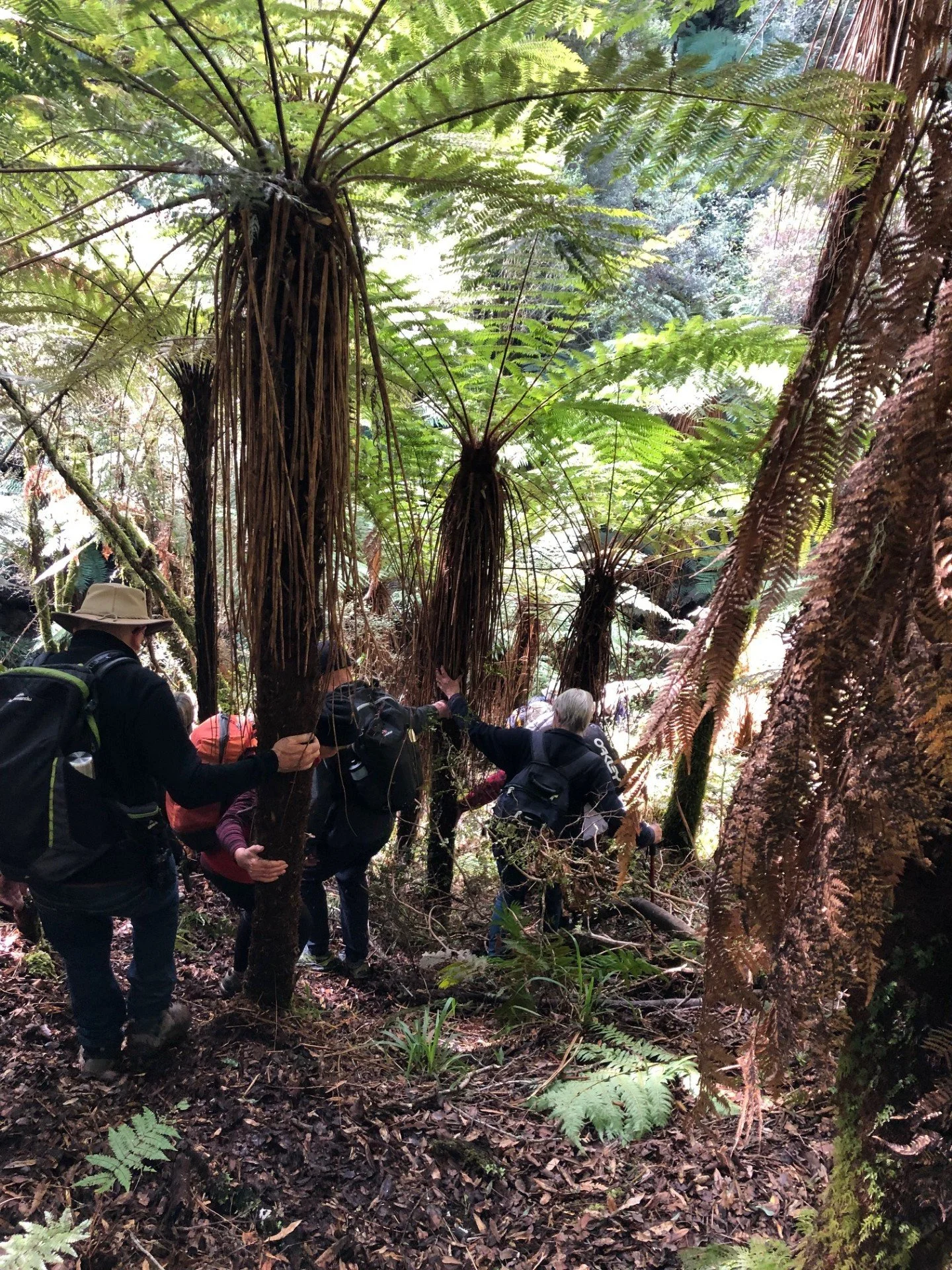The ‘Dinosaur Forest’
The bridge over Whirinaki River at the Whāiti Nui-a Toi Canyon.
If we were eggs, we would have been cracked and scrambled by the time we arrived at the River Road carpark in the Whirinaki Te Pua-a- Tāne Conservation Park.
All was forgiven as we gazed skyward at the enormous trees surrounding us, all part of a 56,000-hectare area of what the famous botanist David Bellany once described as a ‘Dinosaur Forest’.
The survival and protection of both this forest and Pureora owes much to changing attitudes in the 1970’s and 80’s towards conservation and the preciousness of New Zealand’s native trees.
Our destination was Vern’s Campsite which is approximately 8km along the track to the Central Whirinaki Hut.
Stately podocarps, green tree ferns and soft coverings of mosses gave the forest an aura of timelessness and peace and attests to the inevitability of the cycle of growth and decay.
Rimu, tōtara, miro, kahikatea and mataī, all members of the cone bearing genus, have thrived here with some reaching the dizzying height of 65 metres.
Within minutes we were crossing the bridge over Whirinaki River at the Whāiti Nui-a Toi Canyon.
The sound of the water being forced through the ravine was akin to being by an ocean.
Further on we heard the harsh screams of kākā and saw the flash of their reddish, orange underwing as they flew above us.
Flocks of the fast-moving pōpokotea or whiteheads twittered as they went about their business of catching insects.
Their canary like song is said to increase when stormy weather is approaching and European settlers used their call as an early warning system.
We found a little nest on the forest floor. It was neatly interwoven with moss and may have belonged to them.
The track surface varied from gentle leaf layering, sandy areas, slippery, muddy sections or coarse metal chips. Generally, the track is wide but there were completely eroded sections necessitating a scramble up the bank on a detour and a little toboggan-like activity on slippery mud to get down on our return.
There was windfall and fallen widowmakers or epiphytes alongside, and in some cases, over the track.
Strangely shaped and old and decaying trees stood amongst their living offspring.
Kākā are known to tear the bark of these trees to extract sap and eat the grubs hiding within.
One fallen trunk had numerous empty holes but probably once housed puriri moth larva.
Long sections of the track follow the fast-flowing river.
Huge trees had collapsed into the water, and one had a row of orange fungi making an orderly line across the trunk as if making a break for the opposite bank.
We were fortunate that a walker heard the shrill ‘whio’ whistle.
A well camouflaged pair were resting on rocks just below overhanging trees.
These territorial birds are regarded as nationally vulnerable and Whirinaki Forest is one of very few security sites established to protect them.
Usually pairs live 1-5km apart and we were thrilled to see another pair sunning themselves on our side of the river quite close to the first pair.
Whio have bills with soft flaps on either side so they can scrape invertebrates off the rocks without damaging themselves and are adapted to living in fast flowing water that many other ducks could not survive in.
All too soon we were at Vern’s Campsite.
This is an open clearing with campsites for three tents and a sturdy A-framed shelter.
Benched seats, a table, sleep mats, pots and pans and even a long drop.
Pīwakawaka flittered and flirted with us and a miromiro or tomtit maintained a more respectful distance and watched the proceedings.
We ate and rested there and left reluctantly.
Our return on the same track was just as beautiful and interesting.
We turned down the track to the Waiatiu Falls. This is a short and easy diversion with great views of the water tumbling through the small rocky gap from the bridge and a ledge just below it.
A further detour off the main track had us peering over the bank at the moss- covered rocks of the canyon.
They were like columns hewed in straight lines with contorted bases with strange holes punched out be the force of the water.
The whio made a repeat appearance, several trout loitered in a calm pool and the kākā were even noisier and restless, moving quickly from tree to tree.
A brightly coloured peacock strutting by a fence and a group of ‘free-range’ chestnut- coloured horses running beside the road added extra interest to the drive home.
This was a long day but one full of colour and wonder and worth every minute. Next Monday we will be seaside.
If you would like more information, please email walkersmondaytaupo@gmail.com or follow us on Facebook at ‘Taupo Monday Walkers’


